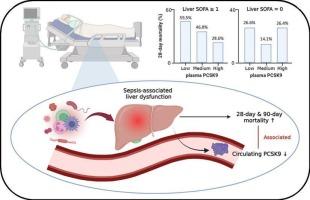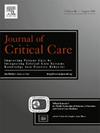脓毒症相关的肝功能障碍混淆了脓毒症患者循环PCSK9浓度与死亡率之间的关系:一项单中心回顾性队列研究
IF 2.9
3区 医学
Q2 CRITICAL CARE MEDICINE
引用次数: 0
摘要
前蛋白转化酶枯草杆菌素/激酶蛋白9 (PCSK9)是脓毒症的潜在治疗靶点。然而,其作为预后生物标志物的作用尚不清楚。本研究探讨了脓毒症患者血浆PCSK9浓度与死亡率的关系,重点探讨了脓毒症相关性肝功能障碍(SALD)的影响。方法入选符合脓毒症-3标准的患者。入院24小时内采集血浆样本。根据PCSK9浓度对患者进行分组,随访进行生存分析。采用Cox比例风险模型和受限三次样条曲线进行进一步分析。结果共纳入415例患者。低PCSK9组28天死亡率较高。在肝顺序器官衰竭评分(SOFA)≥1的患者中,PCSK9浓度与死亡率呈负线性相关,而在肝顺序器官衰竭评分(SOFA) = 0的患者中呈u型相关。在整个队列中,调整国际标准化比率和肝脏SOFA降低了PCSK9浓度与死亡率之间的相关性。结论低血浆PCSK9浓度与脓毒症死亡率的关系可能受SALD的影响。进一步研究PCSK9在脓毒症中的作用应考虑肝功能障碍对PCSK9合成和预后的影响。本文章由计算机程序翻译,如有差异,请以英文原文为准。

Sepsis-associated liver dysfunction confounds the association between circulating PCSK9 concentration and mortality in septic patients: A single-center retrospective cohort study
Background
Pro-protein convertase subtilisin/kexin 9 (PCSK9) is a potential therapeutic target in sepsis. However, its role as a prognostic biomarker remains unclear. This study investigated the relationship between plasma PCSK9 concentration and mortality in septic patients, focusing on the impact of sepsis-associated liver dysfunction (SALD).
Methods
Patients meeting the Sepsis-3 criteria were enrolled. Plasma samples were collected within 24 h of admission. Patients were grouped into tertiles based on PCSK9 concentration and followed up for survival analysis. Further analyses were performed using Cox proportional hazard models and restricted cubic spline curves.
Results
A total 415 of patients were enrolled. Low PCSK9 group exhibited higher 28-day mortality. Among patients with liver sequential organ failure score (SOFA) ≥ 1, PCSK9 concentration displayed an inverse linear correlation with mortality, in contrast to a U-shaped pattern among those with liver SOFA = 0. Adjustment for international normalized ratio and liver SOFA diminished the significance of the association between PCSK9 concentration and mortality in the entire cohort.
Conclusion
The association between low plasma PCSK9 concentration and mortality in sepsis may be influenced by SALD. Further investigations into the role of PCSK9 in sepsis should consider the impact of liver dysfunction on PCSK9 synthesis and prognosis.
求助全文
通过发布文献求助,成功后即可免费获取论文全文。
去求助
来源期刊

Journal of critical care
医学-危重病医学
CiteScore
8.60
自引率
2.70%
发文量
237
审稿时长
23 days
期刊介绍:
The Journal of Critical Care, the official publication of the World Federation of Societies of Intensive and Critical Care Medicine (WFSICCM), is a leading international, peer-reviewed journal providing original research, review articles, tutorials, and invited articles for physicians and allied health professionals involved in treating the critically ill. The Journal aims to improve patient care by furthering understanding of health systems research and its integration into clinical practice.
The Journal will include articles which discuss:
All aspects of health services research in critical care
System based practice in anesthesiology, perioperative and critical care medicine
The interface between anesthesiology, critical care medicine and pain
Integrating intraoperative management in preparation for postoperative critical care management and recovery
Optimizing patient management, i.e., exploring the interface between evidence-based principles or clinical insight into management and care of complex patients
The team approach in the OR and ICU
System-based research
Medical ethics
Technology in medicine
Seminars discussing current, state of the art, and sometimes controversial topics in anesthesiology, critical care medicine, and professional education
Residency Education.
 求助内容:
求助内容: 应助结果提醒方式:
应助结果提醒方式:


